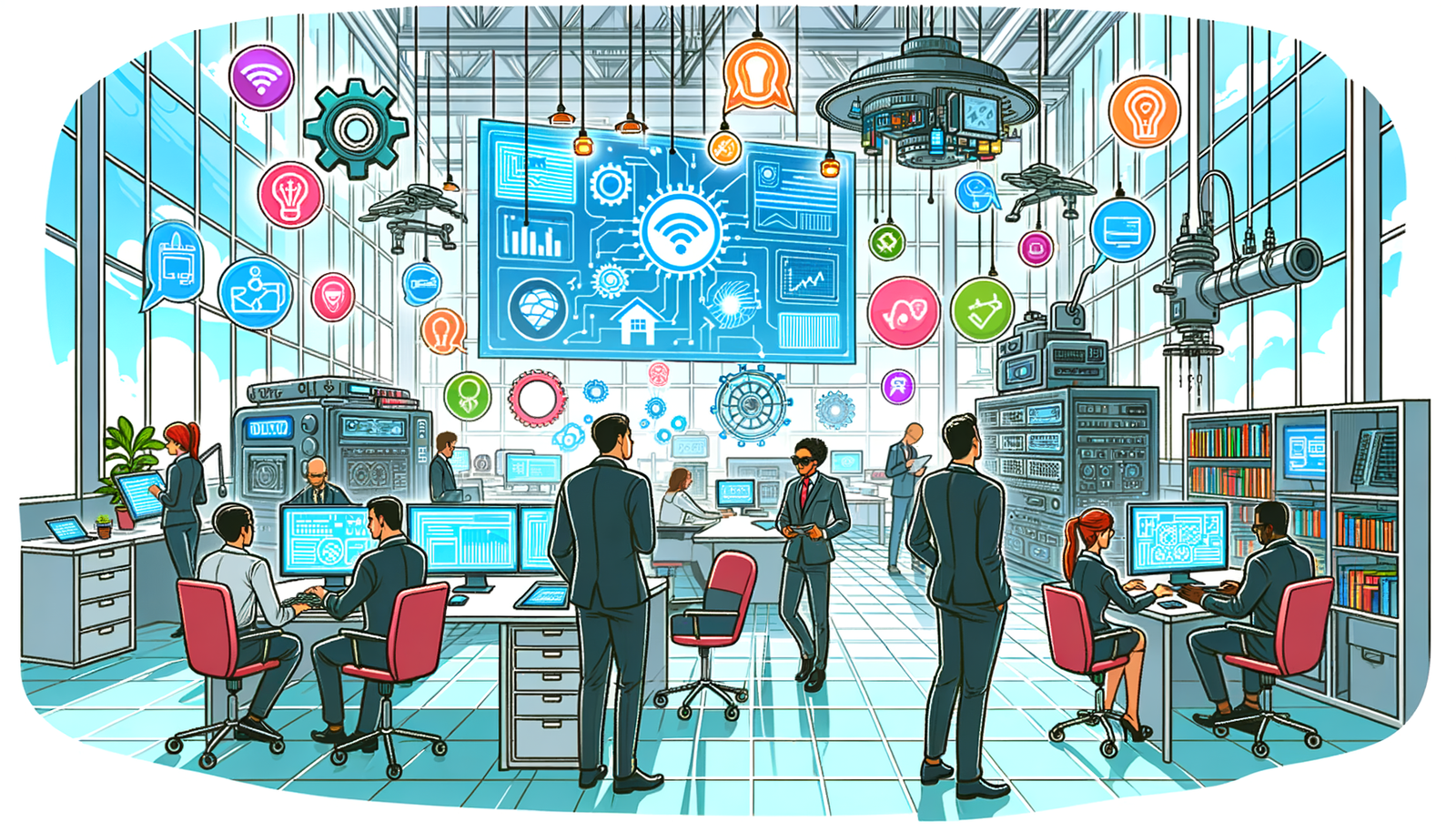Your Cart is Empty
Customer Testimonials
-
"Great customer service. The folks at Novedge were super helpful in navigating a somewhat complicated order including software upgrades and serial numbers in various stages of inactivity. They were friendly and helpful throughout the process.."
Ruben Ruckmark
"Quick & very helpful. We have been using Novedge for years and are very happy with their quick service when we need to make a purchase and excellent support resolving any issues."
Will Woodson
"Scott is the best. He reminds me about subscriptions dates, guides me in the correct direction for updates. He always responds promptly to me. He is literally the reason I continue to work with Novedge and will do so in the future."
Edward Mchugh
"Calvin Lok is “the man”. After my purchase of Sketchup 2021, he called me and provided step-by-step instructions to ease me through difficulties I was having with the setup of my new software."
Mike Borzage
Leveraging APIs for Enhanced Integration and Innovation in Design Software
November 20, 2024 10 min read


In the rapidly evolving field of design software, the integration of various tools and applications has become a key factor in enhancing productivity and innovation. Application Programming Interfaces (APIs) serve as the fundamental building blocks that enable this integration, allowing different software systems to communicate and interact seamlessly. By understanding the role of APIs, design professionals can leverage these technologies to streamline their workflows and create more cohesive design environments.
Understanding APIs in Design Software
Definition of APIs
Application Programming Interfaces (APIs) are sets of protocols, tools, and definitions that allow different software applications to communicate with each other. They act as intermediaries that enable software components to interact, share data, and execute functions in a standardized manner. In the context of design software, APIs facilitate the integration of various design tools, enabling them to work together harmoniously within a single workflow.
The primary function of APIs is to provide a set of standardized methods through which software applications can request and exchange information. This ensures that regardless of the underlying programming languages or platforms, different applications can interact without compatibility issues. For design professionals, this means that the tools they use for modeling, rendering, simulation, and other functions can be connected to create a unified and efficient design environment.
The importance of APIs in software communication and interaction cannot be overstated. They not only enable the integration of existing tools but also allow for the extension of software capabilities. Developers can use APIs to add new features, customize functionalities, and create specialized applications that meet specific industry needs. This flexibility is crucial in the dynamic field of design, where innovation and adaptability are key to staying competitive.
Moreover, APIs help in reducing development time and costs by allowing developers to reuse existing code and functionalities rather than building everything from scratch. This reuse of components fosters a collaborative ecosystem where software applications can leverage each other's strengths. For instance, a rendering software can use the API of a modeling tool to directly access and manipulate design data, eliminating the need for manual file imports and exports.
In addition, APIs play a critical role in enhancing user experience by enabling the creation of integrated solutions that are tailored to specific workflows. Design professionals can customize their software environments by selecting and integrating the tools that best fit their needs. This level of customization is made possible through the use of APIs, which provide the necessary interfaces for software communication.
Overall, APIs serve as the connective tissue of the software world, enabling disparate systems to function as a cohesive whole. In the realm of design software, this means more efficient workflows, reduced errors, and the ability to innovate by combining the best features of different applications. Understanding and leveraging APIs is therefore essential for any design professional looking to enhance their software integration and overall productivity.
Types of APIs
APIs come in various forms, each serving different purposes and offering different levels of accessibility. Understanding the different types of APIs is crucial for effectively leveraging them in design workflows. The three primary types of APIs are Public APIs, Private APIs, and Partner APIs.
Public APIs are APIs that are accessible by developers outside the organization that created them. They are designed to provide external developers with access to certain functionalities or data of a software application. In the context of design software, public APIs allow third-party developers to create plugins, extensions, or integrations that enhance the capabilities of the core software. This openness fosters innovation and allows for a broader range of tools and features that can benefit users.
Public APIs are typically well-documented and come with developer support to encourage widespread use. They enable the creation of an ecosystem around a software application, where developers contribute their own solutions that can be shared with the user community. This collaborative approach leads to a more versatile and powerful set of tools for design professionals.
Private APIs are intended for internal use within an organization. They are not exposed to external developers and are used to integrate various internal systems and applications. For design firms, private APIs can be used to connect proprietary design tools with other internal systems, such as project management software, databases, or collaboration platforms. This internal connectivity ensures that all systems can share data and functionality, leading to more efficient workflows and better coordination among teams.
Using private APIs allows organizations to tailor their software environment to their specific needs without exposing sensitive data or functionalities to the outside world. It provides a secure way to enhance integration and automation within the organization's infrastructure.
Partner APIs are shared with select business partners to facilitate collaborative experiences and integrations. They offer a controlled way to provide certain external parties with access to specific functionalities or data. In the design industry, partner APIs can enable collaboration between software vendors, allowing for the integration of complementary tools and services. For example, a CAD software company might provide a partner API to a simulation software vendor to enable seamless data exchange between their applications.
Partner APIs help in building strategic relationships and partnerships, leading to enhanced capabilities for both parties involved. They are typically more restrictive than public APIs, with access limited to authorized partners and governed by agreements that define the terms of use.
By understanding these different types of APIs, design professionals and organizations can make informed decisions about how to integrate and extend their software environments. Whether it's leveraging public APIs to enhance functionality, using private APIs to streamline internal processes, or utilizing partner APIs for strategic collaborations, each type offers unique benefits that can significantly impact the efficiency and effectiveness of design workflows.
Advantages of Using APIs in Design Workflows
Seamless Integration
In the complex landscape of design workflows, multiple software systems are often employed to handle various aspects of the design process. From initial concept modeling to detailed simulations and final renderings, each phase may utilize specialized tools. APIs enable different software systems to work together by providing the necessary interfaces for communication and data exchange. This seamless integration is essential for creating efficient and cohesive workflows that minimize redundancies and errors.
By utilizing APIs, design professionals can connect their preferred tools in a way that allows for real-time data synchronization. For example, changes made in a 3D modeling software can be automatically reflected in a rendering application without the need for manual file exports and imports. This not only saves time but also reduces the risk of inconsistencies and data loss.
Popular design tools offer robust APIs that allow for extensive integrations. Through these APIs, developers can create plugins or extensions that add new functionalities or connect the software with other applications. This has led to the development of a rich ecosystem of integrations that enhance the capabilities of these tools.
Key benefits of seamless integration through APIs include:
- Improved Efficiency: Automation of data transfer and synchronization reduces manual workload.
- Enhanced Collaboration: Teams can work across different tools while remaining connected.
- Consistency: Unified data formats and standards minimize errors and inconsistencies.
By leveraging APIs for seamless integration, design professionals can create a more streamlined and productive workflow that allows them to focus on creativity and innovation rather than technical obstacles.
In addition to connecting standalone applications, APIs facilitate integration with cloud services and collaborative platforms. With the increasing trend towards remote work and distributed teams, the ability to integrate design software with cloud-based storage and project management tools has become increasingly important. APIs enable this connectivity, allowing for secure access to design data from anywhere and fostering collaboration among team members.
Moreover, APIs support the integration of emerging technologies such as virtual reality (VR) and augmented reality (AR) into design workflows. By connecting traditional design software with VR/AR platforms through APIs, designers can create immersive experiences that enhance visualization and client presentations. This level of integration opens up new possibilities for interacting with designs and receiving feedback.
Another significant aspect is the ability to integrate with manufacturing systems. In industries like additive manufacturing, APIs can connect design software directly with 3D printing machines, enabling a streamlined process from design to production. This direct line of communication reduces lead times and allows for rapid prototyping and iterative design processes.
In summary, seamless integration through APIs not only connects different software tools but also bridges the gap between various stages of the design and production process. It enhances the overall efficiency of workflows, promotes innovation, and enables designers to fully leverage the capabilities of the tools at their disposal.
Enhanced Customizability
APIs provide the foundation for tailoring software functionalities to meet specific user needs. In the diverse field of design, one size does not fit all, and professionals often require specialized tools and features to address unique challenges. Through APIs, developers and users can customize and extend software capabilities, creating solutions that are specifically aligned with their workflows and objectives.
Customization through APIs can range from simple modifications, such as automating repetitive tasks, to developing entirely new functionalities that address specific industry requirements. For instance, a design firm specializing in architectural visualization might use APIs to create custom plugins that integrate their modeling software with advanced rendering tools, enabling more photorealistic visualizations.
Key ways in which APIs enhance customizability include:
- Automation: Scripts and plugins can be developed to automate repetitive tasks, increasing efficiency.
- Integration of Specialized Tools: APIs allow for the inclusion of niche applications or services that provide specialized functionalities.
- Customization of User Interfaces: Users can modify the software interface to better suit their workflow preferences.
- Development of New Features: APIs enable the creation of entirely new functionalities that can be added to existing software.
By harnessing the power of APIs, organizations can create a tailored software environment that optimizes productivity and fosters innovation. This level of customization is particularly valuable in competitive industries where unique capabilities can provide a significant advantage.
Furthermore, APIs empower users to respond quickly to changing requirements or new opportunities. Instead of waiting for software vendors to release updates or new features, organizations can develop their own solutions, ensuring that their tools remain aligned with their evolving needs. This agility is crucial in the fast-paced world of design, where staying ahead of trends can make a significant difference.
Increased Efficiency
One of the most significant advantages of using APIs in design workflows is the potential for increased efficiency. By automating repetitive tasks and reducing manual input, APIs help streamline processes, allowing designers to focus more on creative and strategic aspects of their work. Automation not only saves time but also reduces the likelihood of errors that can occur with manual data handling.
For example, APIs can be used to automatically generate reports, update data across multiple applications, or trigger specific actions based on events. In a design workflow, this might include:
- Synchronizing Design Changes: Updates in one software application are automatically reflected in others.
- Automating Data Transfer: Design data is seamlessly transferred between modeling, simulation, and rendering tools.
- Generating Documentation: Reports and documentation are automatically created based on design data.
These automated processes can significantly reduce the time spent on administrative tasks, allowing designers to devote more time to critical thinking and innovation.
Moreover, APIs support the integration of advanced technologies such as artificial intelligence (AI) and machine learning into design workflows. By connecting design software with AI-powered tools through APIs, designers can leverage predictive analytics, generative design, and other cutting-edge capabilities that enhance efficiency and open up new creative possibilities.
In conclusion, the use of APIs to increase efficiency is a powerful strategy for design professionals seeking to optimize their workflows. By automating routine tasks and enabling advanced integrations, APIs help unlock greater productivity and allow teams to achieve more with less effort.
Challenges and Future Directions
Interoperability Issues
While APIs offer significant benefits in terms of integration and customization, they also present challenges, particularly regarding interoperability. Integrating multiple APIs from different vendors can lead to compatibility issues, as each API may have its own standards, protocols, and data formats. This lack of standardization can complicate the integration process and require additional effort to ensure that systems work together effectively.
Common challenges faced when integrating multiple APIs include:
- Inconsistent Data Formats: Different applications may use varying data structures, requiring data transformation.
- Conflicting Protocols: APIs may use different communication protocols, leading to compatibility issues.
- Versioning Conflicts: Updates to APIs can introduce changes that break existing integrations.
- Lack of Documentation: Insufficient or unclear documentation can make it difficult to implement integrations correctly.
To address these challenges, there is potential for improved standards in API development. Industry-wide adoption of common protocols and data formats can facilitate smoother integrations. Organizations like the OpenAPI Initiative work towards standardizing API development practices, which can help mitigate interoperability issues.
Design professionals can also employ strategies such as using middleware or integration platforms that abstract the differences between APIs. These tools can manage the complexity of integrating multiple systems, providing a unified interface and simplifying the overall process.
Security Considerations
The integration of multiple systems through APIs introduces security risks that must be carefully managed. APIs can become potential points of vulnerability if not properly secured, exposing sensitive data and systems to unauthorized access or cyberattacks. The importance of maintaining secure data exchange in API integrations is paramount to protect both intellectual property and personal data.
Key security considerations include:
- Authentication and Authorization: Ensuring that only authorized users and applications can access API functionalities.
- Data Encryption: Protecting data in transit and at rest through encryption.
- Input Validation: Preventing injection attacks by validating all inputs received through APIs.
- Regular Security Audits: Monitoring and assessing APIs for vulnerabilities and compliance with security standards.
Design professionals and organizations can implement strategies to mitigate security risks associated with APIs, such as:
- Using Secure API Gateways: Implementing gateways that manage and secure API traffic.
- Adhering to Security Best Practices: Following guidelines such as OWASP API Security Top 10.
- Implementing Robust Monitoring: Continuously monitoring API usage and detecting anomalies.
- Educating Development Teams: Ensuring that developers are aware of security risks and trained in secure coding practices.
By proactively addressing security considerations, organizations can safely leverage APIs to enhance their design workflows without exposing themselves to unnecessary risks.
Future Trends
The landscape of APIs in design software is continually evolving, with emerging technologies set to have a significant impact on API development and utilization. Predictions for the evolution of APIs include:
- Adoption of AI and Machine Learning: APIs will increasingly integrate AI capabilities, enabling more intelligent and adaptive functionalities within design software.
- Growth of the Internet of Things (IoT): APIs will connect design software with a broader array of devices and sensors, facilitating real-time data collection and interaction.
- Microservices Architecture: The move towards microservices will change how APIs are developed and implemented, promoting greater modularity and scalability.
- Enhanced Standardization: Efforts towards standardizing APIs will improve interoperability and ease of integration.
The impact of emerging technologies like AI and IoT on API development is particularly significant. For instance, AI-powered APIs can provide advanced analytics, automate complex tasks, and enhance decision-making processes within design workflows. IoT integrations can enable real-time feedback from physical devices, informing design adjustments and innovations.
Design professionals must stay abreast of these trends to leverage new opportunities and maintain a competitive edge. Embracing the evolving role of APIs will be essential for fostering innovation and increasing efficiency in design workflows.
Conclusion
In summary, APIs play a transformative role in enhancing design software integration by enabling seamless communication between different applications, providing opportunities for customization, and increasing overall efficiency. They serve as essential tools that empower design professionals to create more cohesive and effective workflows.
As the industry continues to evolve, the need to embrace API technology becomes ever more critical. Design professionals who leverage APIs are better positioned to foster innovation, respond to emerging trends, and stay ahead in the competitive landscape of design and manufacturing.
By exploring new API solutions and staying informed about future directions, professionals and organizations can unlock new potentials, drive productivity, and contribute to the advancement of the design industry as a whole.
Also in Design News

Automating Compliance Checks in Architectural Design: Balancing Innovation with Regulation
November 21, 2024 5 min read
Read More
Design Software History: Revolutionizing Design: The Impact of IoT on Workflow Efficiency and Innovation
November 21, 2024 10 min read
Read More
ZBrush Tip: Enhancing Realism in ZBrush: Advanced Techniques for Sculpting Hands and Feet
November 20, 2024 2 min read
Read MoreSubscribe
Sign up to get the latest on sales, new releases and more …


